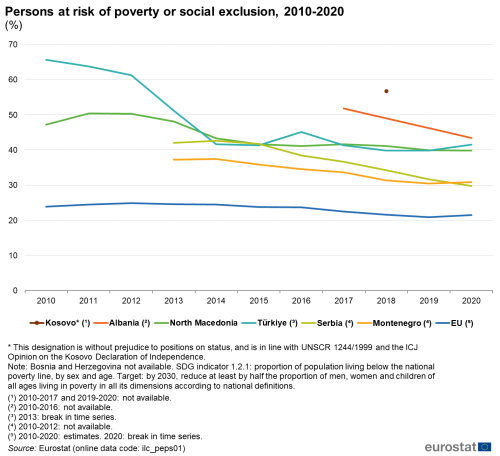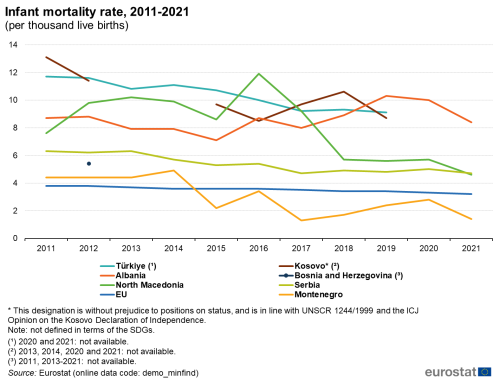Enlargement countries - indicators for Sustainable Development Goals
Data extracted in May 2023.
Planned article update: May 2024.
Highlights
This article is part of an online publication and provides information on a range of indicators for sustainable development statistics for the Western Balkans and Türkiye and compares this with corresponding data for the European Union (EU). Within this region, Bosnia and Herzegovina, Montenegro, North Macedonia, Albania, Serbia and Türkiye are candidate countries, while Kosovo* has the status of potential candidate.
Data for Georgia, Moldova and Ukraine, granted candidate status or European perspective by the European Council in June 2022, are not included in this article; Statistics Explained articles on the European Neighbourhood Policy-East countries are available here.
*This designation is without prejudice to positions on status, and is in line with UNSCR 1244/1999 and the ICJ Opinion on the Kosovo declaration of independence.
Full article
General overview
In September 2015, the United Nations (UN) adopted an agenda titled Transforming our world: the 2030 Agenda for Sustainable Development. In order to keep track of progress for delivering this 2030 Agenda in a systematic and transparent way, Eurostat, together with other services of the European Commission (EC), seeks to highlight, through the release of a wide range of official statistics for the European Union (EU), the progress being made and the challenges being faced with respect to the 17 Sustainable Development Goals (SDGs).
This article presents ad-hoc information for the Western Balkans and Türkiye and is based on indicators that currently form part of Eurostat’s regular data collection exercise, rather than a specific data collection exercise related to SDGs; the data can be found on Eurostat’s online database (Eurobase).
The information provided below follows a descriptive approach, presenting a statistical picture of the situation for a number of SDGs that have been selected primarily on the basis of data availability; as such, the article covers only five of the SDGs. It provides a brief description of the targets developed by the UN for each of these five goals and presents specific indicators — among those selected by the UN — to measure progress being made towards achieving these goals.
SDG 1 — No poverty
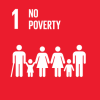
SDG 1 calls for ‘ending poverty in all of its forms across the world’. One of the areas in which progress should be achieved concerns reducing by at least half the proportion of men, women and children of all ages who are living in poverty according to national definitions by 2030 (Target 1.2). To do so, the UN has defined Indicator 1.2.1 as the proportion of population living below the national poverty line, by sex and age.
The data presented in Figure 1 show the proportion of the population considered to be at risk of poverty or social exclusion (abbreviated AROPE), a key poverty indicator. This is the sum of people that are either at-risk-of-poverty after social transfers, severely materially deprived or living in households with very low work intensity. It should be noted that persons are counted only once, even if they are affected by more than one of these phenomena.
The share of people at risk of poverty is calculated in relation to those living with an income that is less than 60 % of the national median equivalised income (a commonly used definition for the relative poverty line, otherwise known as a poverty threshold). Poverty rates measure the proportion of the population who are living below the poverty line. Poverty rates are a relative measure because they are calculated separately for each country; someone who is below the poverty line in one country might have been above it in another country (given the same income).
Material deprivation is understood as the inability to afford items considered by most people as desirable or even necessary to lead an adequate life. The indicator focuses on the enforced inability to pay unexpected expenses, afford a one-week annual holiday away from home, a meal involving meat, chicken or fish every second day, the adequate heating of a dwelling, durable goods like a washing machine, colour television, telephone or car, being confronted with payment arrears (mortgage or rent, utility bills, hire purchase instalments or other loan payments). Severe material deprivation is defined as the enforced inability to pay for at least four of these nine items.
Persons living in households with very low work intensity is defined as the number of persons living in a household where the members of working age worked less than 20 % of their total potential during the previous 12 months.
The data shown in Figure 1 are presented after redistribution of income, in other words after social transfers. Across the Western Balkans and Türkiye, the at-risk-of-poverty and social exclusion rate generally fell during the period from 2010 (or the closest year available) to 2019. However, effects of the Covid-19 pandemic on poverty and social exclusion can be discerned in the data, with the poverty rates increasing from 2019 to 2020 in Türkiye and also slightly in Montenegro, and only decreasing marginally in North Macedonia.
The highest rate in the most recent year available was recorded in Kosovo in 2018 with 56.7 %; however, this is the only year available for Kosovo, so it is not possible to assess the development over time. In Albania, the rate fell from 51.8 % in 2017 to 46.2 % in 2019 (-5.6 percentage points (pp)), and continued its decline to 43.4 % (-2.8 pp) in 2020. This was still the highest at-risk-of-poverty and social exclusion rate recorded among the Western Balkans and Türkiye in 2020.
The highest fall over the period 2010-2019 was recorded in Türkiye, where the rate decreased by 25.9 pp from 65.7 % in 2010 to 39.8 % in 2019. Within this period, there were substantial falls in the at-risk-of-poverty and social exclusion rate in both 2013 (-10.1 pp) and 2014 (-9.6 pp); however, in this context it should be noted that there was a methodological break in the time series of Türkiye in 2013. In 2020, the rate increased to 41.5 %, which was 1.7 pp higher than the previous year and the second highest in the Western Balkans and Türkiye group.
The rate in North Macedonia fell from 47.2 % in 2010 to 39.9 % in 2019, but decreased only marginally (-0.1 pp) to 39.8 % from 2019 to 2020. Montenegro recorded an at-risk-of-poverty and social exclusion rate of 30.5 % in 2019, compared to 37.3 % in 2013 (-6.8 pp), but increased slightly to 30.9 % in 2020 (+0.4 pp). Similarly, the rate was down from 42.0 % to 29.8 % (-12.2 pp) in Serbia over the same period, 2013-2020. There is no data available for Bosnia and Herzegovina.
In the EU, the at-risk-of-poverty and social exclusion rate in 2019 amounted to 20.9 %, moderately down (-2.4 pp) compared to 2010, but rose by 0.6 pp to 21.5 % in 2020
SDG 3 — Good health and well-being
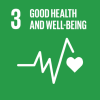
SDG 3 seeks to ‘ensure healthy lives and promote well-being’. Within this context, one of the areas in which development is measured is child mortality, including ending preventable deaths of new-born children by 2030, with all countries aiming to reduce neonatal mortality to 12 or fewer per thousand live births. It should be noted that this indicator is not included on the EU list of SDG indicators.
Traditionally, official statistics have measured the infant mortality rate based on the number of newly born children dying before their first birthday. Generally, in countries with small populations and thus relatively low numbers of births and infant deaths each year, the infant mortality rate tends to fluctuate from year to year. Figure 2 shows that the infant mortality rate in the Western Balkans and Türkiye were higher than that in the EU during the period 2011-2021. The exception was Montenegro, where the rate fell from 4.4 in 2011 to 1.4 in 2021, falling below the EU rate in 2015 and remaining below it since.
The pace at which the infant mortality rate fell between 2010 and 2020 was generally faster among the Western Balkans and Türkiye group than for the EU (where infant mortality rates were already at a relatively low level in 2010). However, the decrease in the infant mortality rate in this group did not follow a smooth falling path, but fluctuated between years with rising rates and years with falling rates.
Albania was an exception; its infant mortality rate, despite overall decreasing from 8.7 to a low at 7.1 deaths per thousand live births between 2010 and 2015 (with the exception of a marginal increase of 0.1 in 2012), subsequently rose and peaked at 10.3 in 2019, before decreasing to 8.4 in 2021. Following a notable and steady decline over the period (except slight increases in 2014 and 2018), the infant mortality rate in Türkiye stood at 9.1 in 2019, the most recent data available, down from 11.7 in 2011.
The rate of Kosovo fluctuated over the period, with a rate of 8.7 in 2019 the most recent available data. This was substantially lower than the 13.1 recorded in 2011, corresponding to a decline by -4-4 over the period, the largest in the group. However, in the period in-between, the rate fluctuated between 11.4 in 2012 and 8.5 in 2016 (data for 2013 and 2014 not available). A strong decline over the period was also recorded in North Macedonia, where the rate of 4.6 deaths per thousand live births in 2021 was much lower than the 7.6 recorded in 2011. The rate fluctuated considerably in-between, with sharp falls in 2017 and 2018 and strong increases in 2012 and 2016.
Within the period 2011-2021, data for the infant mortality rate for Bosnia and Herzegovina is only available for 2012 (5.4). The infant mortality rate in Serbia changed relatively moderately year-on-year, with changes in the range between +0.2 and -0.7. In 2021, the rate stood at 4.7, down from 6.3 in 2011. The infant mortality rate in Montenegro stayed stable at 4.4 2011-2013, before peaking at 4.9 in 2014. The rate more than halved to 2.2 in 2015, falling below the rate of the EU for the first time. Despite an increase to 3.4 in 2016, the rate remained below that of the EU for the rest of the period, falling to a low of 1.3 in 2017. Following a subsequent increase to 2.8 in 2020, it fell sharply to 1.4 in 2021.
The infant mortality rate in the EU either fell marginally or remained constant year-on-year throughout the period, with changes in the range -0.1 to 0.0, decreasing steadily from 3.8 infant deaths per thousand live births in 2011 to 3.2 in 2021.
Some of the indicators used to monitor the SDGs have been developed outside the scope of official statistics or taking account of potential future developments for official statistics. While the standard definition that tends to be applied for the infant mortality rate refers to infant deaths up to the age of one year, the UN has agreed upon the use of SDG Indicator 3.2.2 to focus on deaths of new-borns during the first 28 days of life — the neonatal mortality rate; as with the infant mortality rate, the neonatal mortality rate is expressed per thousand live births.
There is no available information on neonatal mortality rates — as presented in Figure 3 — for the EU as a whole. Instead, data are shown for the EU Member States with the highest and the lowest rates, respectively, in 2021. In keeping with the data on infant mortality rates, the Western Balkans and Türkiye reported decreases in their neonatal mortality rates.
Kosovo reported 7.5 neonatal deaths per thousand live births in 2019 (latest data available), the highest among the Western Balkans and Türkiye group; this was down from 11.1 in 2011, with the fall across the period of -3.6 the largest within the group. The second highest rate in the most recent year available was recorded in Albania in 2021, with 6.6 neonatal deaths per thousand live births. This was up from 5.6 in 2013, making Albania the only one within the group with a rising netonatal mortality rate over the period (+.10).
For Türkiye, the rate declined to 5.7 by 2019 (latest data available), down from 7.3 in 2011. Serbia recorded a neo-natal mortality rate of 3.7 in 2021, down from 4.7 in 2011, while the rate in North Macedonia fell to 2.9 in 2021 from 5.0 ten years earlier. In Montenegro, the neo-natal mortality rate stood at 0.7 in 2021, down from 3.5 in 2011. Data for Bosnia and Herzegovina is not available for 2021; in 2012, it had a rate of 4.3 neo-natal deaths per thousand live births.
The EU Member States with the highest neonatal mortality rates in 2021 were Bulgaria and Romania, both with 3.1, followed by France, Croatia, Luxembourg and Malta, all with a rate of 2.7. The EU Member States with the lowest neonatal mortality rates in 2021 were Finland (1.2), Slovenia and Czechia (both 1.4). However, Estonia recorded an even lower neonatal mortality rate of 0.9 in 2019, the most recent data available for this country.
It should be mentioned that, as for the infant mortality rate, significant fluctuations can easily occur in small populations with low number of births and neonatal deaths, without necessarily indicating any clear trend.
All of the Western Balkans, Türkiye and EU Member States presented in Figure 3 recorded neonatal mortality rates well below the UN target (3.2.2) of 12 per thousand live births.
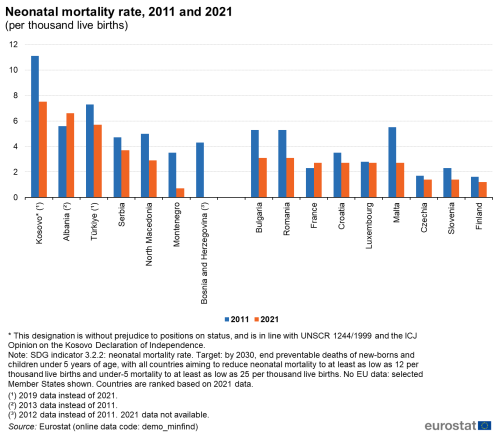
(per thousand live births)
Source: Eurostat (demo_minfind)
SDG 7 — Affordable and clean energy
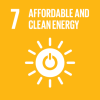
SDG 7 seeks to ‘ensure access to affordable, reliable, sustainable and modern energy for all’. One area of progress that should be achieved concerns doubling the global rate of improvement in energy efficiency by 2030 (Target 7.3). In order to measure progress in this domain, the UN has agreed upon the use of Indicator 7.3.1 as a measure of energy intensity. Energy intensity is used as a proxy for energy efficiency: it can be affected by a number of factors, such as climate or the structure of an economy. This indicator is defined as the gross inland consumption of energy in relation to constant price (or volume) gross domestic product (GDP), in other words, the energy supplied to the economy per unit of economic output; if the ratio declines over time this indicates that less energy is required, thereby confirming that the economy concerned has made progress in relation to energy efficiency gains.
Figure 4 shows that for most of the Western Balkans and Türkiye, energy intensity decreased over the period 2011-2021, suggesting that their economies were becoming more energy efficient. In absolute terms, Kosovo recorded the most substantial decline in energy intensity among the Western Balkans and Türkiye over this period; its energy intensity fell to 405 kilogrammes of oil equivalent per thousand € of GDP in 2020, down 120 (-22.9 %) from the 525 recorded in 2011. In North Macedonia there was an overall reduction in the amount of energy required to produce a unit of GDP of 29.3 % between 2011 and 2021, the largest relative decrease within the group, falling to 268 kilogrammes of oil equivalent per thousand € of GDP in 2021 from 380 in 2011. In Serbia the reduction was 20.7 %, from 468 in 2011 to 371 in 2021.
For Montenegro, the energy intensity decreased by 19.4 % from 329 kilogrammes of oil equivalent per thousand € of GDP in 2011 to 265 in 2021. Albania’s energy intensity declined by 15.8 % from 233 in 2011 to 196 in 2020 (2021 not available). Türkiye had by far the lowest energy intensity among the Western Balkans and Türkiye, falling by 13.2 % from 184 kilogrammes of oil equivalent per thousand € of GDP in 2011 to 160 in 2021.
The energy intensity in the EU fell gradually from 2011 to 2021, reaching 110 kilogrammes of oil equivalent per thousand € of GDP in 2021. Despite their efficiency gains, the amount of energy required to produce a unit of GDP remained considerably higher in the Western Balkans and Türkiye than in the EU: in 2021, energy intensity ratios among this group were generally 1.8-3.8 times as high as in the EU, with Türkiye recording the lowest difference with an energy intensity 1.4 times as high as in the EU.
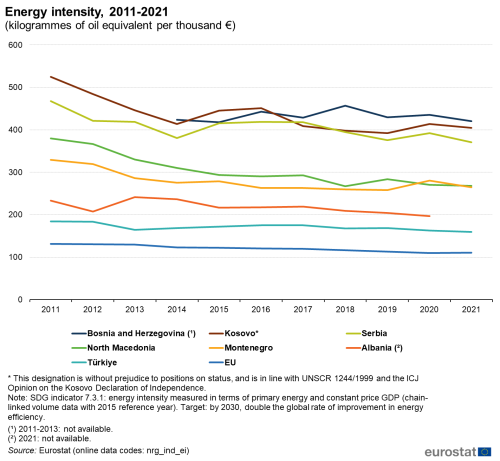
(kilogrammes of oil equivalent per thousand €)
Source: Eurostat (nrg_ind_ei)
SDG 8 — Decent work and economic growth
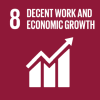
SDG 8 aims to ‘promote sustained, inclusive and sustainable economic growth, full and productive employment and decent work for all’. As part of this, one target is to sustain economic growth per inhabitant in accordance with national circumstances and, in particular, at least 7 % growth per annum in the least developed countries (Target 8.1). To measure progress towards this target, the UN has agreed upon Indicator 8.1.1. This indicator is retained in the EU list of SDG indicators and is defined as the annual growth rate of real GDP per capita; it is often used as a proxy to measure the health of an economy. Although frequently used as a key economic indicator, GDP is often criticised in discussions concerning sustainable development insofar as one of its main limitations is that it fails to capture social and environmental costs of production.
The information shown in Figure 5 relates to year-on-year (annual) changes in GDP per capita in constant price (or volume) terms, adjusting for inflation in nominal prices. Among the Western Balkans and Türkiye, these data are not available for Bosnia and Herzegovina and Kosovo.
The real rate of change in GDP per capita was positive in 2011 in all five countries for which data are available, marking the beginning of the recovery from the global financial and economic crisis of 2009- 2010. The subsequent global sovereign debt crisis led to a slow-down in 2012 with negative real rate of change in GDP per capita for Montenegro (-2.8 %) and to a lesser extent for North Macedonia (-0.6 %) and Serbia (-0.2 %). In contrast, Albania and Türkiye continued the positive growth (respectively +1.6 % and +3.5 %) in 2012. Between 2013 and 2018, the GDP per capita grew in all five countries, with the only exception being Serbia (-1.1 %) in 2014. In 2019, GDP per capita fell slightly in Türkiye (-0.6 %), but continued to grow strongly in Serbia (+4.9 %), Montenegro (+4.1 %), North Macedonia (+3.9 %) and at a slightly slower pace in Albania (+2.5 %). In 2020, the economic effects of the Covid-19 pandemic resulted in a sharp decline in the real rate of change in GDP per capita in Montenegro (-15.2 %) and to a lesser extent in North Macedonia (-4.5 %) and Albania (-2.9 %). In Serbia, GDP per capita decreased only marginally in real terms (-0.2 %), while in Türkiye it increased (+1.0 %). In 2021, Montenegro and Türkiye had a real rate of change in GDP per capita higher than 10 %, with respectively 13.4 % and 10.3 %. Provisional data for 2022 for Serbia shows considerable growth (+3.2 %), similar to that of the EU (+3.3). There is no 2022 data available yet for North Macedonia, Albania, Türkiye and Montenegro.
Through the period studied, the Western Balkans and Türkiye showed, as a general trend, increases in GDP per capita larger than those observed for the EU. However, the real changes in GDP per capita followed a similar pattern. In 2020, reflecting the negative economic effects of the COVID-19 pandemic, the real rate of change in GDP per capita fell sharply in the EU (-5.7 %), just as in most of the Western Balkans and Türkiye. In 2021, that fall from the previous year was almost completely recovered (+5.5 %).
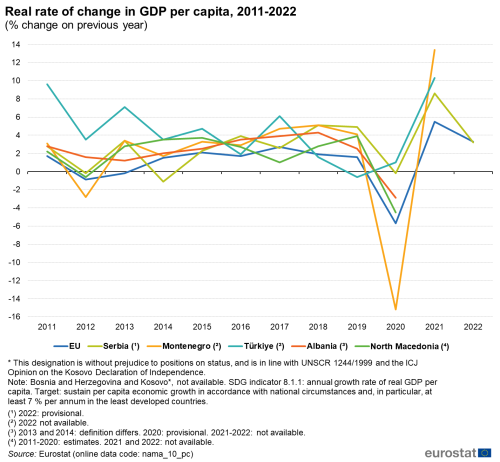
(% change on previous year)
Source: Eurostat (nama_10_pc)
Another issue covered in Goal 8 of the SDGs concerns ‘achieving full and productive employment and decent work for all women and men, including for young people and persons with disabilities, and equal pay for work of equal value by 2030’.
Figure 6 presents the unemployment rate by sex for 2011 and 2021.
The Western Balkans and Türkiye that have data for both a recent year and another year approximately 10 years earlier, all recorded a decrease in the unemployment rates for both men and women, with the only exception being the unemployment rates in Türkiye which increased between 2011 and 2021, by 4.8 percentage points to 14.9 % for men, and by 4.1 percentage points to 12.4 % for women.
Among the Western Balkans and Türkiye group, the unemployment rates vary broadly. The highest rates for both men and women were recorded in Kosovo in both 2012 (data not available for 2011) and 2021. In 2012, unemployment was 28.1 % and 40.0 % for men and women, respectively. By 2021, although still the highest within the group, the unemployment rates had decreased substantially for both sexes, to 18.9 % for men and 24.9 % for women.
The lowest unemployment rates for 2011 were recorded in Türkiye for both men (8.3 %) and women (10.1 %). The lowest rates in 2021 were reported in Serbia for men, at 10.2 %, and in Albania for women, at 11.8 %.
In 2021, the Western Balkans and Türkiye generally recorded lower unemployment rates for men than for women. North Macedonia stood out as the only one where this gender gap was reversed in 2020 (data not available for 2021), with unemployment for women, at 15.9 %, lower that that for men, at 16.7 %, a difference of 0.8 percentage points (pp). The largest unemployment gender gaps, with male unemployment lower than that for women, were recorded in Kosovo in both 2012 (data not available for 2011) and 2021, at 11.9 and 6.0 pp difference between men and women. However, it should be noted that the largest decrease in unemployment for women (-15.1 pp between 2012 and 2021) was also recorded in Kosovo, resulting also in the largest reduction in the unemployment gender gap among the Western Balkans and Türkiye.
EU unemployment rates were generally lower than for the Western Balkans and Türkiye. In 2021, the EU unemployment rate stood at 6.8 % for men and 7.4 % for women, down from 9.9 % and 10.3 %, respectively, in 2011. The gender gap in unemployment rates widened slightly in the EU; in 2021 the unemployment rate for women was 0.6 pp higher than that for men; in 2011 it had been 0.4 pp higher (see Figure 6).
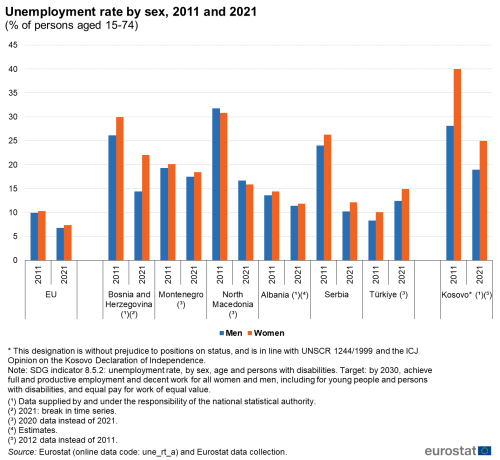
(% of persons aged 15-74)
Source: Eurostat (une_rt_a) and Eurostat data collection
An analysis of the unemployment rate by age is also considered essential in this context, as policymakers tend to focus their attention on both ends of working life, analysing employment opportunities for the young and the retention of older members of the workforce up to and beyond the official retirement age (if one exists).
Among young people aged 15-24 years who were economically active (i.e. either employed or unemployed), unemployment stood at between 25 % and 39 % in the Western Balkans and Türkiye group in 2021 (see Figure 7). The highest youth unemployment rate in 2021 among this group was recorded in Bosnia and Herzegovina with 38.3 %; Bosnia and Herzegovina also had the highest youth unemployment during 2011-2016. From 2012-2016, Kosovo recorded the second highest youth unemployment rate, but the highest between 2017 and 2020. One reason for the youth unemployment in Kosovo overtaking that in Bosnia and Herzegovina was a rapid decrease in youth unemployment in Bosnia and Herzegovina from 2016 on, with substantial decreases of 8.0 pp in 2016, 8.5 pp in 2017, 7.0 pp in 2018, and 5.0 pp in 2019. However, in 2020, marked by the Covid-19 pandemic, Bosnia and Herzegovina recorded a small increase in youth unemployment (+2.8 pp), which continued into 2021 (+1.6 pp).
Montenegro had the third highest youth unemployment rate in 2020 (data not available for 2021), at 36.0 %, almost at the same level as in 2011 (36.6 %); Montenegro’s youth unemployment rate peaked in 2012 at 42.2 %, while reaching its lowest level at 25.2 % in 2019. North Macedonia followed closely, with 35.7 % in 2021, sharply down from 55.3 % in 2011, its highest rate of the period; its lowest rate was recorded in 2019 (35.6 %).
The others in the group, Albania, Serbia and Türkiye, all registered youth unemployment rates between 25.1 % and 27.7 % in 2021 (2020 for Türkiye – data not available for 2021), however their paths over the period since 2011 differed. The rate in Serbia increased between 2011 and 2012 (from 53.1 % to 53.3 %), before falling consistently every year to 26.4 % in 2021. The youth unemployment rate in Albania increased consistently from 23.9 % in 2011, its lowest level, to a peak at 39.8 % in 2015, before falling steadily to 26.5 in 2020. However, the youth unemployment rate in Albania ended the period with a slight increase to 27.1 % in 2021. In contrast, the youth unemployment rate in Türkiye generally recorded year-on-year increases from 2012 onwards: during the whole period from 2011 to 2016, the rate was below 20.0 %, which was lower than the youth unemployment rate in the EU in this period. From the low of 15.7 % in 2012, the rate in Türkiye grew steadily to 2017. Following a sharp upturn in youth unemployment by +5.0 pp in 2019, Türkiye ended the period with a rate of 25.1 % in 2020 (data not available for 2021).
The youth unemployment rate in the EU stayed above 20 % between 2011 (22.6 %) and 2016 (20.7 %), with a peak at 25.2 % in 2013. The youth unemployment rate declined steadily from that peak, falling to 15.6 % in 2019. In 2020, a year heavily impacted by the effects of the Covid-19 pandemic, it increased to 17.6 %; this was still lower than in any of the Western Balkans and Türkiye. In 2021, it decreased to 16.7 %.
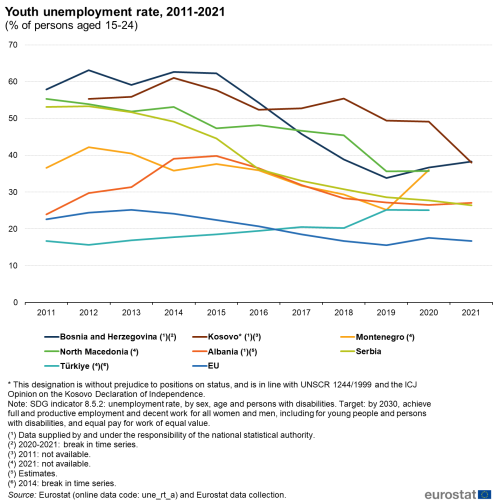
(% of persons aged 15-24)
Source: Eurostat (une_rt_a) and Eurostat data collection
The final indicator presented for SDG 8 is ‘to decrease the proportion of youth not in employment, education or training to 9 % by 2030’. To measure progress towards this target, the EU monitors the share of young persons (aged 15-29 years) who are neither in employment nor in education and training, otherwise referred to as the NEET rate (Indicator 08_20). Note that this ratio is calculated as a share of all young persons, excluding only those for whom it is unknown whether they remain within the educational system or not.
The highest NEET rates among the Western Balkans and Türkiye group were recorded in Türkiye for the years 2011 and 2019-2020 and in North Macedonia for the years 2012-2018 (see Figure 8). The NEET rate in Türkiye decreased continuously between 2011 and 2017, from the peak at 32.7 % in 2011 to its lowest level at 27.5 % in 2017. From 2018 to 2020, the NEET rate in Türkiye increased from 27.6 % to 32.0 % (data not available for 2021). Over the period 2011-2020 as a whole, the NEET rate decreased by 0.7 pp.
North Macedonia recorded the highest NEET rates in the group between 2012 and 2018, ranging from 32.5 % in 2015 – its highest point – to 29.8 % in 2018. In 2019 it decreased by 5.3 pp, falling to its lowest level of the period, at 24.5 %. In 2020 (latest data available), the rate stood at 26.2 %. Over the period 2011-2020, the NEET rate decreased by 5.9 pp in total.
From 2011 to 2019, the NEET rates of Montenegro and Serbia followed each other closely, before Montenegro recorded a 5.3 pp increase in 2020, compared with an increase of only 1.0 pp in Serbia, which increased the gap between them. Montenegro’s NEET rate in 2020 (data not available for 2021) stood at 26.6 % - its peak within the period; its lowest point was in 2018, at 21.0 %. Overall, Montenegro’s NEET rate increased by 2.2 pp between 2011 and 2020. Serbia’s rate in 2021 stood at 18.8 %, its lowest level; its highest was recorded in 2011 and 2012. Over the period 2011-2021, the NEET rate in Serbia decreased by 7.4 pp.
Generally, the NEET rates increased from 2019 to 2020 across the Western Balkans and Türkiye, as in the EU, in connection with the Covid-19 pandemic. Over the period 2011-2021, on average close to a third of young people in North Macedonia (30.2 %) and Türkiye (29.4 %) (both 2011-2020; 2021 data not available) were neither in employment nor in education or training. The average NEET rate over this period was somewhat less than a quarter in Serbia (22.7 %) and Montenegro (23.1 %, 2011-2020 data). There is no data available on NEET for Albania, Bosnia and Herzegovina and Kosovo.
In 2021 (or the most recent year available), the NEET rate was higher across the Western Balkans and Türkiye than in the EU, where it stood at 13.1 %. Throughout the whole period 2011-2021, the NEET rate in the EU, at an average of 14.5 %, lay well below the rates in the Western Balkans and Türkiye.
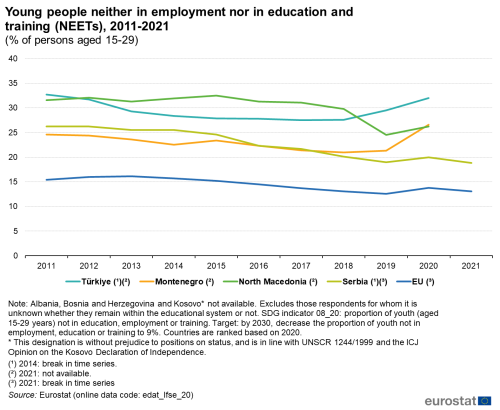
(% of persons aged 15-29)
Source: Eurostat (edat_lfse_20)
SDG 17 — Partnerships for the goals
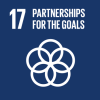
SDG 17 calls for the goal of ‘strengthening the means of implementation and revitalising the global partnership for sustainable development’. As part of this, one target is to ‘fully operationalize the technology bank and science, technology and innovation capacity-building mechanism for least developed countries by 2017 and enhance the use of enabling technology, in particular information and communications technology’ (Target 17.8). In recent decades, the internet has become an increasingly important tool for providing access to information: it can help foster access to science, technology and innovation, and share knowledge. For insights into the progress within this area, the UN has agreed upon Indicator 17.8.1. This indicator appears in the EU list of SDG indicators and is defined as the proportion of individuals using the Internet.
The data presented in Figure 9 show the frequency of internet use by individuals aged between 16 and 74. The rates are calculated for three different intensities of internet use: trimester usage (use in the last three months), weekly usage (at least once a week, but not daily) and daily usage. It can be noticed that the share of individuals that report using the internet weekly (but not daily) is very small compared with trimester use and daily use.
The highest change in the frequency of internet use between 2011 and 2022 was found in Serbia, where there was an increase from 38.1 % in 2012 (data not available for 2011), to 83.5 % in 2022 in the use of the internet in the last 3 months, an increase by 45.4 pp; Türkiye recorded similar levels to those of Serbia, in 2012 (data not available for 2011) at 42.7 % and in 2022 at 83.4 %. The highest change in daily use of the internet was also recorded in Serbia, with an increase from 25.0 % in 2012 (data not available for 2011) to 81.5 % in 2022, up 56.5 pp; it was followed by Türkiye, up by 53.3 pp, from 26.7 % in 2012 (data not available for 2011) to 80.0 % in 2022.
Kosovo reported the highest proportions among the Western Balkans and Türkiye of individuals aged 16 to 74 years old that, in 2020 (latest available data), used internet in the last 3 months (95.6 %) or used the internet daily (92.9 %); however, data for comparison with 2011 is not available for Kosovo. In 2022, the shares of individuals who used the internet at least once a week (but not daily) ranged from 1.8 % in Serbia to 6.1 % in Albania. Data for comparison with 2011 is not available for Bosnia and Herzegovina, Albania, and Kosovo; for the other four of the Western Balkans and Türkiye group, these shares of individuals who only used the internet at least once a week (but not daily) were below the levels recorded in 2011.
In the EU, internet use in the most recent trimester increased from 69.4 % in 2011 to 90.0 % in 2022, while the daily use increased from 54.0 % in 2011 to 84.0 % in 2022. The share of individuals who only used the internet at least once a week (but not daily) decreased from 11.4 % to 4.6 % over the same period.
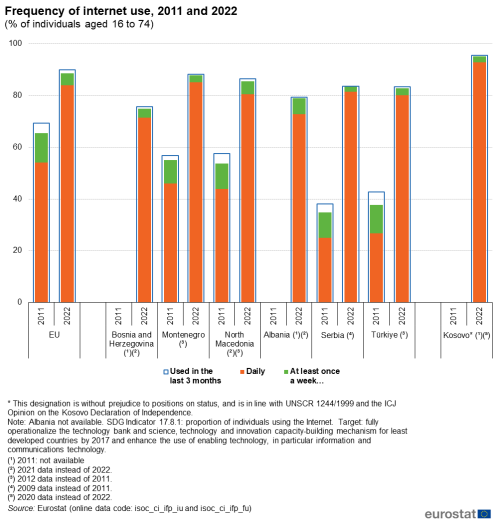
(% of individuals aged 16 to 74)
Source: Eurostat (isoc_ci_ifp_iu) and (isoc_ci_ifp_fu)
Source data for tables and graphs
Data sources
The data for the Western Balkans and Türkiye presented in this article are mainly relying on regular information collected by Eurostat units responsible for data collection in specific domains, such as national accounts, population and migration, energy, etc. As such, the data presented in this article for these statistics are generally sourced from the same datasets as those providing information for the EU aggregate.
The statistics are available free-of-charge on Eurostat’s website, together with a range of additional indicators covering most socio-economic topics.
In some cases, when the data required are not available through Eurostat's regular data collection exercises, the missing data may be drawn from data supplied by and under the responsibility of the national statistical authorities of the Western Balkans and Türkiye. These data result from a range of data collection exercises established by Eurostat, through questionnaire surveying of a limited number of areas of official statistics.
While basic principles and institutional frameworks for producing statistics are already in place, the Western Balkans and Türkiye are expected to increase progressively the volume and quality of their data and to transmit these data to Eurostat in the context of the EU enlargement process. EU standards in the field of statistics require the existence of a statistical infrastructure based on principles such as professional independence, impartiality, relevance, confidentiality of individual data and easy access to official statistics; they cover methodology, classifications and standards for production.
Eurostat has the responsibility to ensure that statistical production of the candidate countries and potential candidates complies with the EU acquis in the field of statistics. To do so, Eurostat supports the national statistical offices and other producers of official statistics through a range of initiatives, such as pilot surveys, training courses, traineeships, study visits, workshops and seminars, and participation in meetings within the European Statistical System (ESS). The ultimate goal is the provision of harmonised, high-quality data that conforms to European and international standards. Additional information on statistical cooperation with the enlargement countries is provided here.
Context
Sustainable development is a global concern that is linked to a wide range of economic, social and environmental challenges present within the world. However, sustainable development also provides opportunities, such as the potential to eliminate extreme poverty or measures that are designed to stimulate a sustainable path to economic growth.
In September 2015, an important milestone was reached, as the UN adopted a new agenda titled Transforming our world: the 2030 Agenda for Sustainable Development.
UN indicators for measuring sustainable development
The UN’s 2030 agenda for sustainable development is a long-term policy designed to bring about a systemic change in the way that economic growth, social cohesion and environmental protection go hand in hand. It addresses both poverty eradication and the economic, social and environmental dimensions of sustainable development, underpinned by good governance.
The agenda covers a set of 17 Sustainable Development Goals (SDGs) — each designed to address a range of global challenges:
- no poverty;
- zero hunger;
- good health and well-being;
- quality education;
- gender equality;
- clean water and sanitation;
- affordable and clean energy;
- decent work and economic growth;
- industry, innovation and infrastructure;
- reduced inequalities;
- sustainable cities and communities;
- responsible consumption and production;
- climate action;
- life below water;
- life on land;
- peace, justice and strong institutions;
- partnerships for the goals.
In March 2016, the United Nations Statistical Commission (UNSC) agreed on a global list of indicators as a practical starting point to monitor the 17 SDGs and 169 targets at a global level. The SDG indicators framework is refined annually.
The monitoring of SDGs is based on different levels of analyses (referred to by the UN as ‘tiers’). Only indicators in the first of these three tiers have an agreed concept, an established methodology and the regular release of data; the other two tiers suffer either from a lack of regular data collection (Tier 2 indicators) or from the lack of established concepts, definitions, methodologies or standards (Tier 3 indicators). Indeed, the UN continues to work on defining the scope and coverage of Tier 3 indicators. A Resolution was adopted by the General Assembly in 2017 committing to revising the UN indicator list over time, with substantive changes and revisions foreseen in 2025. Following the most recent refinements of the global indicator framework, the current list is composed of 248 indicators (13 of which inform more than one target, meaning there are 231 unique indicators in total). The global indicator list will, as well, be complemented by indicators at the regional and national levels, which are being developed by the UN member states.
For more information on work being conducted in this area and the approach adopted by UN for the development of SDG indicators, please refer to UN’s SDG indicators website. The UN releases quarterly updates of its global database for SDG indicators; it is available online.
Sustainable development — what role for the European Union?
Sustainable development is a fundamental and overarching objective of the EU. Indeed, it is enshrined in Article 3 of the Treaty on European Union. The EU has committed to implementing the UN 2030 agenda for sustainable development, both in its internal and external policies. In November 2016, the European Commission made a proposal for a new European consensus on development — our world, our dignity, our future (COM(2016) 740 final) which highlighted the possibilities available for developing a new framework for achieving sustainable development and poverty eradication. This proposal states that the 2030 agenda should be used to guide EU actions with neighbouring countries, including the candidate countries and potential candidates. Furthermore, the Communication also proposes that the EU should seek to boost the statistical capacity of developing countries, including: strengthened capacity for the production and analysis of data (disaggregated where possible by income, gender, age and other factors); information on marginalised, vulnerable and hard-to-reach groups; inclusive governance; investment in stronger statistical institutions at national and regional level; the promotion and use of new technologies and data sources.
In November 2016, the European Commission also adopted a Communication titled Next steps for a sustainable European future — European action for sustainability (COM(2016) 739 final), identifying that the EU’s global strategy on foreign and security policy had clear links with the UN 2030 agenda for sustainable development, whereby links and benefits for the EU could be achieved by promoting security and prosperity in surrounding regions, including candidate countries and potential candidates and European neighbourhood policy (ENP) countries. Furthermore, the Communication foresees the development of an SDG indicator framework, whereby the European Commission will ‘seek to carry out more detailed regular monitoring of the SDGs in an EU context’ which should draw on work already being carried out by the European Commission and its agencies, as well as the European External Action Service.
As the statistical office of the EU, Eurostat may consider that there are a number of UN indicators which lie outside the scope of official statistics, for example, indicators on governance. Furthermore, in developed economies, some of the indicators from the UN indicator list for monitoring SDGs may be considered as being of little or no relevance, as they refer to issues that are more pertinent for analysing developing countries. Examples include indicators measuring the share of the population that is living within close proximity of a paved road or the availability of modern methods for family planning.
With this in mind, and following the Communication on European action for sustainability, European Commission services have developed an EU-specific indicator list, designed to measure progress in relation to sustainable development issues. The EU’s monitoring framework for SDGs is based largely on data that is already available for the EU Member States (the ‘acquis’); this divergence in approach to that adopted by the UN reflects the considerable differences in economic, social and environmental developments across the different continents, regions and countries of the world and the degree of relevance for some UN indicators with respect to measuring progress on sustainable development issues in the EU.
The EU SDG indicator set is subject to annual reviews to incorporate indicators from new data sources and to consider new targets in line with EU priorities, such as the European Green Deal and other initiatives. The most recent update of the EU SDG indicator set and up-to-date data can be found in Eurostat's online database on SDG.
For more information on work already conducted in this area and the approach adopted by Eurostat, please refer to the dedicated section on Sustainable development goals on Eurostat’s website.
Additional information on statistical cooperation with the candidate countries and potential candidates is provided here.
Direct access to
- All articles on non-EU countries
- Enlargement countries — statistical overview — online publication
- Statistical cooperation — online publication
- All articles on sustainable development goals
- EU SDG indicators: goal by goal
- SDG 1 - No poverty
- SDG 3 - Good Health and well-being
- SDG 7 - Affordable and clean energy
- SDG 8 - Decent work and economic growth
- SDG 17 - Partnerships for the goals
- Enlargement countries – Energy statistics
- Statistical books/pocketbooks
- Key figures on enlargement countries — 2019 edition
- Key figures on enlargement countries — 2017 edition
- Key figures on the enlargement countries — 2014 edition
- Sustainable development in the European Union — Monitoring report on progress towards the SDGs in an EU context — 2021 edition
- Sustainable development in the European Union — Monitoring report on progress towards the SDGs in an EU context — 2020 edition
- Sustainable development in the European Union — Monitoring report on progress towards the SDGs in an EU context — 2019 edition
- Sustainable development in the European Union — A statistical glance from the viewpoint of the UN Sustainable Development Goals
- Factsheets
- Basic figures on the candidate countries and potential candidates — Factsheets — 2023 edition
- Basic figures on Western Balkans and Türkiye — Factsheets — 2022 edition
- Basic figures on enlargement countries — Factsheets — 2021 edition
- Leaflets
- Basic figures on enlargement countries — 2020 edition
- Basic figures on enlargement countries — 2019 edition
- Basic figures on enlargement countries — 2018 edition
- Basic figures on enlargement countries — 2016 edition
- Sustainable development in the European Union — Overview of progress towards the SDGs in an EU context — 2021 edition
- Sustainable development in the European Union — Overview of progress towards the SDGs in an EU context — 2020 edition
- Sustainable development in the European Union — Overview of progress towards the SDGs in an EU context — 2019 edition
- Sustainable development in the European Union — Overview of progress towards the SDGs in an EU context — 2018 edition
- European Commission — Directorate-General Environment
- European Commission — Communication — Next steps for a sustainable European future: European action for sustainability COM(2016) 739 final
- European Commission — European Neighbourhood Policy and Enlargement Negotiations
- United Nations — The Sustainable Development Goals Report
- United Nations — Sustainable Development Goals Indicators — Global database
- United Nations — Sustainable Development Goals Indicators — Metadata repository
- United Nations — Sustainable Development Goals Indicators — Official list of indicators

